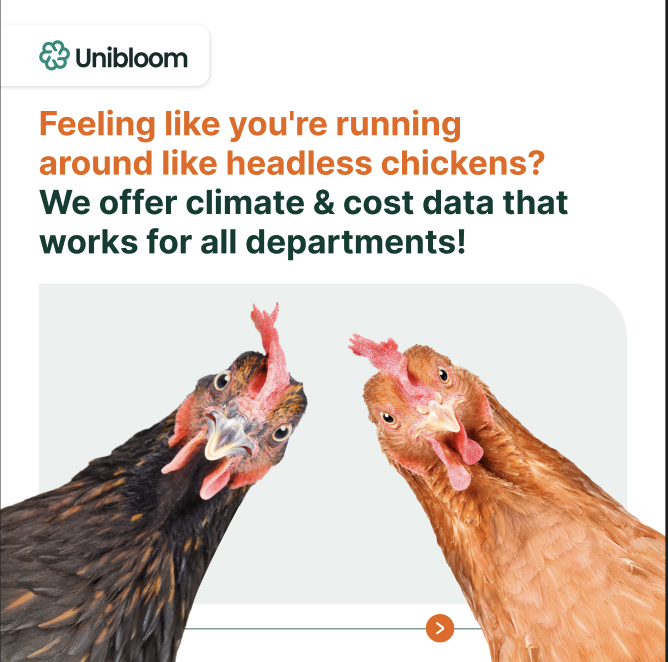Use Unibloom to navigate FLAG Emissions with ease and meet SBTi commitments and regulations

As more companies commit to Science-Based Climate targets, a significant portion of global emissions continues to fly under the radar: those from forests, land, and agriculture (commonly referred to as FLAG). According to the Science Based Targets initiative (SBTi), these emissions make up 22% of all global greenhouse gas emissions. Yet these are commonly left out of corporate inventories, largely because emissions are tracked at the country, regional, or global level under broad categories like LULUCF (Land Use, Land-Use Change, and Forestry) or AFOLU (Agriculture, Forestry and Other Land Use). Previously, these emissions weren’t considered the direct responsibility of companies, even those whose operations depended heavily on land-intensive ingredients like palm oil, soy, or beef.
Recognizing the urgent need to address land-sector emissions at the company level, SBTi introduced FLAG targets, carving out a distinct category from traditional energy- and industry-related emissions, offering companies both clarity and accountability. The initiative currently validates targets aligned with 1.5°C for Scope 1 and 2 emissions, and either 1.5°C or “well below 2°C” for Scope 3. If your business is in a sector like agricultural production, animal-sourced food, forestry and paper, food and beverage processing, retailing of food and staples, or tobacco, and especially if more than 30% of your total emissions fall under FLAG, you’re required to set separate FLAG targets.
Among these FLAG emissions, land use change is a particularly significant driver, accounting for around 11% of global emissions, mostly from deforestation linked to agriculture and forestry. For many companies, these emissions occur “up to the farm gate”, that is, during the production phase of crops and livestock, before any significant processing or energy consumption begins.
Historically, many firms had no clear way to measure, report and set targets to reduce these emissions, but that challenge has now been addressed. SBTi’s guidance provides methodologies to isolate FLAG emissions, assess their impact, and incorporate them into overall decarbonization plans. This separation is critical not just for compliance, but for credibility and real reduction. A climate target that fails to include land-related emissions is fundamentally incomplete. The Greenhouse Gas Protocol’s Land Sector and Removals Initiative is similarly focused on supporting companies in accounting for land-related emissions. By promoting clearer methodologies for tracking emissions from land use change, carbon removals and storage, and biogenic products, the initiative encourages organizations to take responsibility for the climate impacts linked to their land practices. The development of internationally recognized guidance in these areas highlights the growing urgency and importance of incorporating FLAG emissions into corporate GHG reporting at the organizational level.
Real-world examples demonstrate that tackling FLAG emissions isn’t just possible, it can be transformative. Take Mars Incorporated, the multinational known for its food, pet care, and confectionery brands. Mars began including emissions from land use change (LUC) in its Scope 3 tracking back in 2015. They found LUC to be the second-largest contributor to their overall emissions. By targeting this specific area, Mars is aiming to reduce 5.2 million tons of CO₂e, and sees significant additional potential through 2030. Their example shows that addressing FLAG emissions is not just a matter of obligation; it’s a strategic opportunity for impact.
For many companies, however, the data challenge remains daunting. Emissions data tied to land use and agriculture is often hard to access, inconsistent, or missing entirely at the ingredient level. Even companies that have already set science-based targets may be unsure how to split FLAG and non-FLAG emissions, how to forecast reductions, or how to report progress. This is where Unibloom steps in. We help companies utilise datasets on FLAG emissions from commercial databases and in cases where commercial databases are insufficient, develop bespoke datasets with our scientific expertise, in order to inform their decisions on target setting and the emission reduction initiatives needed to meet such targets. In addition to setting and validating FLAG-aligned SBTi targets, with the Unibloom platform, you can build a roadmap of your climate transition plan linked to financials and risks, that works even when inputs are incomplete.
Whether you're sourcing soy from Brazil or dairy from the EU, we help separate and model the emissions tied to FLAG, land use and land management across your value chain. It’s no longer enough to address only the emissions from factories, fleets, and electricity. Land-related emissions are no longer optional, they are central to the climate equation. As FLAG guidance becomes more widely adopted and scrutinized, stakeholders, investors, and regulators will expect companies to report transparently and act decisively. The good news? With the right partners and tools, you don’t need perfect data to get started.
At Unibloom, we make it easier for companies to take this step, digitised, integrated and data-driven. Whether you’re just beginning your journey toward FLAG target-setting, or you’ve already identified land-based emissions in your Scope 3 inventory, we help you unlock the insights, projections, and credibility you need through our precise database and integrated automated modelling of unlimited solutions.
Do as other clients and partners to Unibloom have done - digitise, integrate and make more sustainable & cost-effective decisions with precise data. Check out:
Contact anna.sandgren@unibloom.world or book a demo: calendly.com/anna-sandgren
Watch a short video here to learn more



